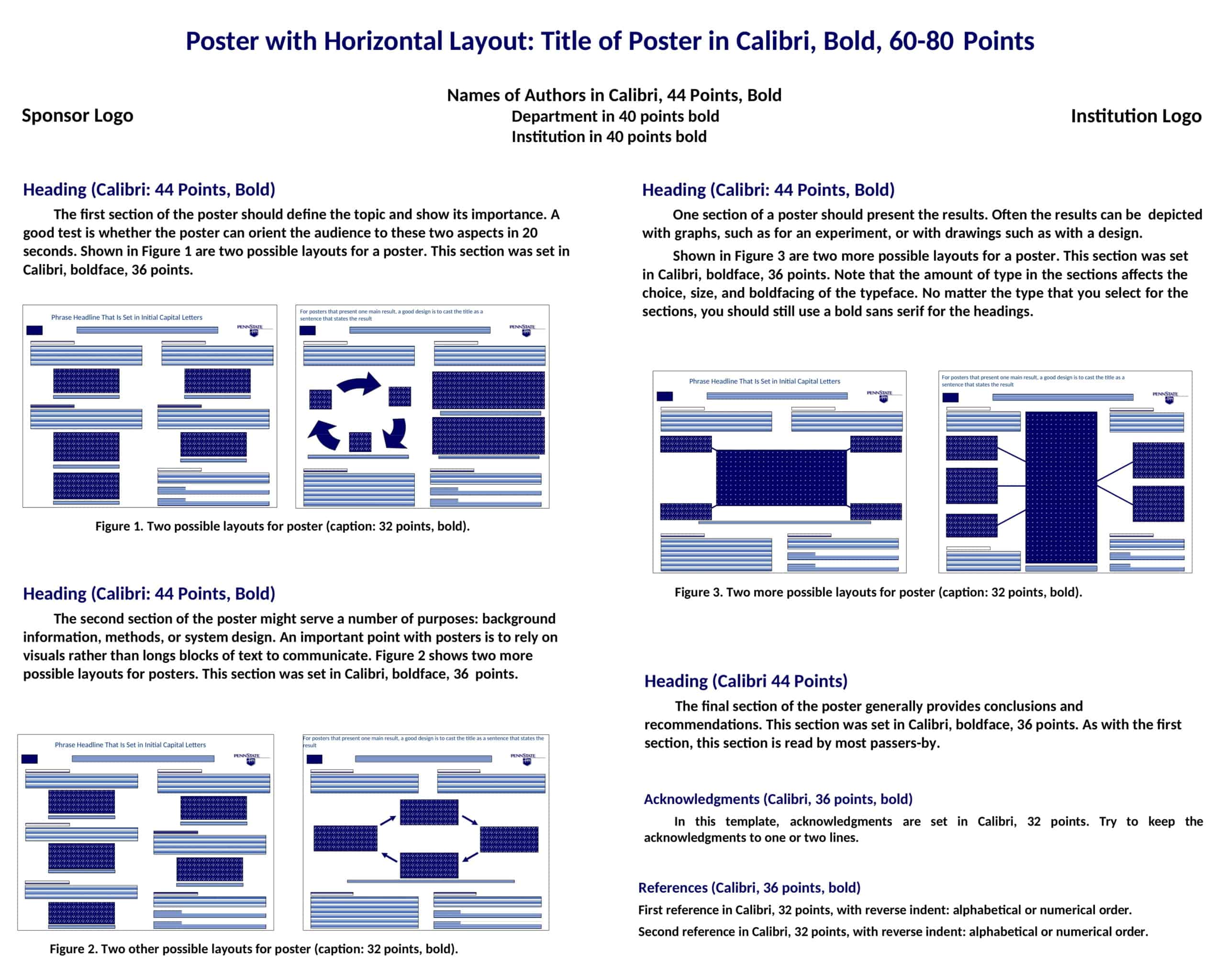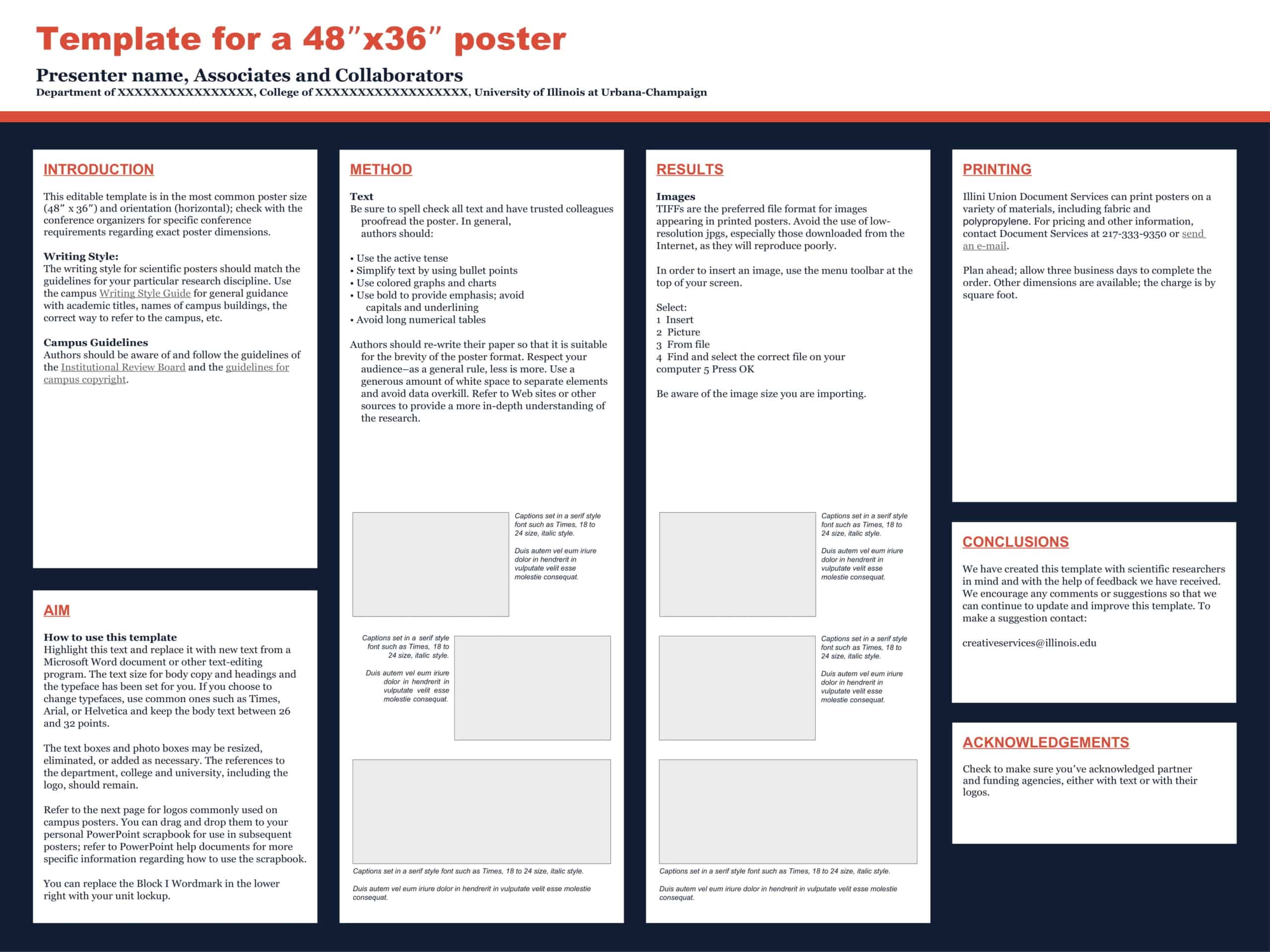Research posters are one of the best ways to improve your presentational skills. This is because they allow you to share and emphasize your research visually. As you grow as a lecturer, a poster will also increase your credibility in front of your peers.
Table of Contents
What is a Research Poster?

A research poster is a visual display of your research. It can be used to present the results of your project at conferences, symposia, and other academic gatherings. By submitting your findings in this way, you can communicate your ideas to an audience more quickly than through oral presentations alone. The goal of the poster session is for attendees to leave with a better understanding of the topic than when they arrived, as well as an interest in learning more about it in the future.
Research Poster Templates
Present your research findings with impact and professionalism using our extensive collection of Research Poster Templates. These templates are designed to help you create visually appealing and informative posters to showcase your research projects, academic studies, or scientific findings. With customizable sections for abstract, methodology, results, and conclusion, our templates provide a structured format that is both engaging and easy to read.
Whether you’re a student presenting at a conference or a researcher sharing your work with colleagues, our Research Poster Templates offer a variety of design options to suit your style and content. Stand out from the crowd and effectively communicate your research with eye-catching visuals and concise information. Download our templates now and create impressive research posters that leave a lasting impression.
What makes a research poster attractive?
A good research poster is one that communicates your message clearly, concisely, and effectively.
It should be visually appealing, with a clear structure, concise information, and well-designed images.
The best way to ensure that your poster will meet these criteria is to follow the tips below:
- Start by defining the purpose of your poster. Is it a research-based project? A demonstration? A marketing tool? Then decide on the target audience and what they need to know.
- Once you know who will view your poster, think about how you can make it relevant to them. This means that you need to understand their needs, interests, limitations, age group, and gender.
- Next, consider the layout of your poster and whether you need text or graphics more prominently displayed on it so that readers can easily follow along with what they are reading. Make sure that everything is legible at a distance, too – people won’t want to get too close if they need glasses!
- Finally, make sure that there are no spelling or grammatical errors on anything written on your poster – spelling mistakes can really detract from its effectiveness, so take care when proofreading every element before you print off copies for display!
What are the components of a poster?
When creating a poster, it’s essential to organize all of the information on your template into these main components or sections:
Introduction: The introduction should include an overview of what you will discuss in your poster and explain why it is important. This can be done by using bullet points, quotes, or a short paragraph. If you are presenting your poster at a conference, this section should also include a statement about who you are presenting to and where they can find more information about you and your research.
Research: This section will contain all of the relevant scientific data for your study. Use graphs, charts, or photographs to illustrate this information. It’s important that you do not overload this section with too much information — ensure that each graph has enough space so that viewers can easily read it from afar without getting too close.
Conclusion: In this section, summarize what you have discovered from your research and provide any recommendations based on this new information. Your conclusion should also reference any limitations of your study that may affect its validity (i.e., lack of statistical significance).
The layout of your research poster
Your research poster should be designed to make it easy for people to understand what you have done. You should also clarify how it contributes to the field of study.
The following steps will help you create a good layout for your poster:
Size and orientation
The width measures the size in inches and height in inches (e.g., 8×10). The orientation could be vertical or horizontal. If you want to use a vertical poster template, choose one with a landscape orientation. If you want to use a horizontal poster template, choose one with a portrait orientation.
Background
The background should be simple and uncluttered so that your data stands out well. Avoid using busy patterns or images in the background because this could distract from your data visualizations and charts/graphs.
Styles of the title and headings
Use bold or italicized text for titles, subtitles, and headings. If you want to use boldface, make sure it’s not heavy; otherwise, people will have difficulty reading it from afar.
Fonts
Use fonts that are easy to read from afar – like Arial or Times New Roman (or any other font with serifs). The font size should be between 10-12 points for titles and 12-14 points for body text. Make sure there is enough contrast between the background and text colors so that it can be read easily on your poster board. You can also use black or dark blue if you want to add emphasis to certain words or phrases in your poster.
Colors
Color is important for conveying a certain mood or emotion. It is also used to highlight important points during presentations. However, don’t use too many colors at once, as they might distract your audience from the content of your poster. Use colors according to their importance and relevance to your topic.
Alignment and whitespace
Ensure each element is aligned properly so that readers will not beunderstandrrangement of information on the poster. Make sure that there is enough whitespace between different sections so that readers can easily navigate through your poster with ease.
Conclusion
The poster should be appropriate for the audience. The level of detail can be higher or lower. Your general knowledge of the topic increases after you complete the presentation because you have had to define, discuss and outline it more completely and logically in the poster format.
You should aim to meet the needs of both your teacher and your students by maintaining a conversational tone that is not too overly formal. This can help to facilitate discussion during group work sessions. Your poster template for research presentations is an important tool that can help you improve your communication skills.
FAQs
What is a Research Poster?
A Research Poster is a visual communication tool that researchers use to present their findings in a clear, concise, and graphic format. It usually includes text, images, and graphs to convey research methods, results, and conclusions to an audience.
What is the purpose of a Research Poster?
The primary purpose of a research poster is to summarize information or research concisely and attractively to help publicize it and generate discussion among colleagues and peers.
How should a Research Poster be structured?
A typical Research Poster should have a title, abstract, introduction, methods, results, conclusions, references, and acknowledgments. It should be organized in a way that guides the viewer from the introduction to conclusions logically.
What size should a Research Poster be?
The size of a research poster can vary, but common dimensions include 36×48 inches or 42×56 inches. It’s essential to check the requirements of the conference or session where you will be presenting your poster.
How can I design an effective Research Poster?
An effective Research Poster should be visually appealing, easy to read, and straightforward. Use a clean layout, large text, and visuals like graphs or images to represent your data. It’s also helpful to use bullet points to keep information concise.
What software can be used to create a Research Poster?
Popular software for creating research posters includes Adobe Illustrator, Microsoft PowerPoint, and specialized software like PosterGenius. Choose a platform you are comfortable with, and that allows for high-resolution printing.
How should I present my Research Poster?
During a poster session, stand by your poster to explain your research and answer questions. Be prepared to give a brief overview of your work and engage with attendees in a meaningful discussion.
Where can I print my Research Poster?
Many universities have on-campus print shops with large-format printers suitable for printing research posters. Alternatively, local print shops or online printing services can also be used.
How can I transport my Research Poster to a conference?
Research posters can be transported in poster tubes, which protect them from damage. Some presenters opt to print their posters on fabric, which can be folded for easy transportation.
Is there a standard color scheme or template for Research Posters?
There isn’t a one-size-fits-all template or color scheme for research posters as the design may depend on the conference guidelines, your institution, or personal preference. However, it’s advisable to use a clean, professional, and visually pleasing design.








































![Free Printable Roommate Agreement Templates [Word, PDF] 1 Roommate Agreement](https://www.typecalendar.com/wp-content/uploads/2023/06/Roommate-Agreement-150x150.jpg)
![Free Printable Credit Card Authorization Form Templates [PDF, Word, Excel] 2 Credit Card Authorization Form](https://www.typecalendar.com/wp-content/uploads/2023/06/Credit-Card-Authorization-Form-150x150.jpg)
![Free Printable Stock Ledger Templates [Excel,PDF, Word] 3 Stock Ledger](https://www.typecalendar.com/wp-content/uploads/2023/08/Stock-Ledger-150x150.jpg)
